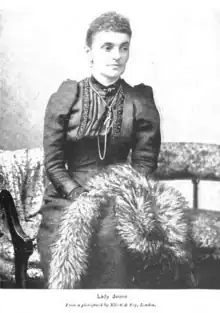Mary Jeune, Baroness St Helier | |
|---|---|
 Lady St Helier in 1896 | |
| Born | Susan Elizabeth Mary Stewart-Mackenzie 18 May 1845 |
| Died | 25 January 1931 (aged 85) London, England |
| Spouses | John Constantine Stanley
(m. 1871; died 1878) |
| Children | 3 |
| Parent(s) | Keith Stewart-Mackenzie Hannah Hope-Vere |
Susan Elizabeth Mary Jeune, Baroness St Helier, DBE (née Mackenzie, previously Stanley; 18 May 1845 – 25 January 1931) was a London County Council alderman and the wife of Francis Jeune, 1st Baron St Helier.
Background
Susan Elizabeth Mary Stewart-Mackenzie was born in Munich, daughter of Keith William Stewart-Mackenzie, of Brahan Castle in the northern Highlands of Scotland, and his wife, Hannah Charlotte Hope-Vere, daughter of James Joseph Hope-Vere. She was the eldest of three children. Her sister Julia Charlotte Sophia (1846–1937) married three times: the soldier and ornithologist Arthur Hay, 9th Marquess of Tweeddale; the Scottish-Canadian businessman and politician Sir John Rose, 1st Baronet; and the politician Sir William Eden Evans-Gordon.[1] Her brother was the soldier James Stewart-Mackenzie, 1st Baron Seaforth.
Marriages and children
.jpg.webp)
She was married, firstly, to Colonel John Constantine Stanley (30 September 1837 – 23 April 1878), son of Edward Stanley, 2nd Baron Stanley of Alderley and Henrietta Maria (née Dillon-Lee), on 15 August 1871. By this marriage she had two daughters:
- Madeline Cecilia Carlyle Stanley (2 July 1876 – 2 June 1966), who was married in 1903 (as his second wife) to St John Brodrick
- Osma Mary Dorothy Stanley (1877 – 6 October 1965), who was married to Augustus Henry Eden Allhusen, JP, DL, of Stoke Court in Buckinghamshire.
She married, secondly, Francis Jeune, later Baron St Helier, on 17 August 1881. Their only child, a son, Francis Jeune, was born in 1882. He died of enteric fever in Poona, India on 19 August 1904.
Life
An indefatigable London hostess, she was a friend of many of the celebrities of her day. The American novelist Edith Wharton mentions her with affection in her memoir 'A Backward Glance' (Chapter 10), and American journalist Ida B. Wells mentions how Lady Jeune supported her anti-lynching campaign by hosting a 'drawing room meeting of her friends' in her autobiography 'Crusade for Justice' (Chapter 20)
During World War I, Lady St Helier befriended a Canadian ex-cavalry officer named William Avery Bishop and used her connections to speed his acceptance into flight school. Billy Bishop went on to become one of the most successful and revered fighter pilots of all time.[2]
In her later years, Lady St Helier resided at Poplar House in the village of Cold Ash, West Berkshire. She donated land for the village's parish room, an early form of community centre, which opened in 1911.[3]
Career
Lady St Helier was a London County Council alderman from 1910 to 1927. She was a very involved philanthropist, founding the All Saints Mission in Islington.[4]
She wrote at least 50 periodical essays, which challenge the idea that Victorian middle and upper-middle class women were not capable of serious nonfiction writing.[2]
Some of her essays have been republished, including "The Revolt of Daughters" (1894) in A New Woman Reader (2001). In 1909, she published a book, Memories of Fifty Years.[2][5][6][7]
She was appointed a Commander of the Order of the British Empire (CBE) in 1920 and elevated to Dame Commander of the Order of the British Empire (DBE) in 1925.
Portrayal in Media
Lady St Helier appears as a character in the Canadian stage musical Billy Bishop Goes to War.
Death
Lady St Helier died on 25 January 1931, aged 85, of unknown causes. She is buried with her husband in St Mary the Virgin churchyard, Chieveley, Berkshire, UK. The estate of St Helier, London was named after her.
References
- ↑ Reynolds, K. D. (2016). "Jeune [née Stewart-Mackenzie other married name Stanley], (Susan Elizabeth) Mary, Lady St Helier (1845–1931), hostess". Oxford Dictionary of National Biography (online ed.). Oxford University Press. doi:10.1093/ref:odnb/51948. ISBN 978-0-19-861412-8. Retrieved 31 May 2021. (Subscription or UK public library membership required.)
- 1 2 3 Davis, William A. (1 April 2015). "Mary Jeune, Late-Victorian Essayist: Fallen Women, New Women, and Poor Children". English Literature in Transition, 1880-1920. 58 (2): 180–208.
- ↑ "Cold Ash - A Brief History of the Development of the Village by Reg Piper". Cold Ash Parish Council. Archived from the original on 24 December 2012. Retrieved 20 September 2019.
- ↑ "Penton Street and Chapel Market area Pages 373-404 Survey of London: Volume 47, Northern Clerkenwell and Pentonville". British History Online. LCC 2008. Retrieved 9 April 2023.
- ↑ Nelson, Carolyn Christensen (2001). A new woman reader: fiction, articles, and drama of the 1890s. Peterborough, Ont.: Broadview Press. ISBN 1551112957.
- ↑ Memories of Fifty Years. London: E. Arnold. 1909. Retrieved 19 October 2016.
- ↑ Stewart-Mackenzie, Lady Jeune, Susan Mary Elizabeth (1 October 1916). "Kitchener–England's man of iron". Haper's Bazaar: 641–50.